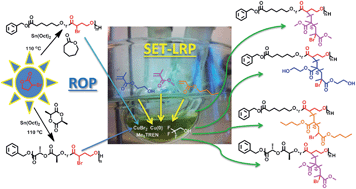In this article, Albertsson and co-workers felt inspired to use γ-lactones as inexpensive and straightforward monomers that can bestow the desired functionality on commonly used aliphatic polyester. More specifically, they used α-bromo-γ-butyrolactone (αBrγBL) as a comonomer with ε-caprolactone (εCL) or L-lactide (LLA) to produce copolymers with active and available grafting sites, e.g., for SET-LRP, where the choice of the grafting monomers is limited only by one’s imagination. The authors believe that αBrγBL inherently holds all the prerequisites to act as a platform monomer for the synthesis of functional aliphatic polyesters, i.e., it is inexpensive, available, and able to form isolated grafting sites along the polymer chain. The incorporation of isolated αBrγBL is a feature that makes this class of copolymers unique and is considered to provide a route to the “perfect graft copolymer” with a degradable backbone.
Establishing α-bromo-γ-butyrolactone as a platform for synthesis of functional aliphatic polyesters – bridging the gap between ROP and SET-LRP by Peter Olsén, Jenny Undin, Karin Odeliusa and Ann-Christine Albertsson, Polym. Chem. 2014, 5, 3847-3854.
Julien Nicolas is a web-writer and advisory board member for Polymer Chemistry. He currently works at Univ. Paris-Sud (FR) as a CNRS researcher.











